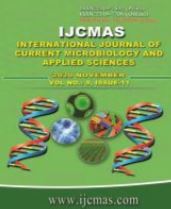


 National Academy of Agricultural Sciences (NAAS)
National Academy of Agricultural Sciences (NAAS)

|
PRINT ISSN : 2319-7692
Online ISSN : 2319-7706 Issues : 12 per year Publisher : Excellent Publishers Email : editorijcmas@gmail.com / submit@ijcmas.com Editor-in-chief: Dr.M.Prakash Index Copernicus ICV 2018: 95.39 NAAS RATING 2020: 5.38 |
A field-cum-laboratory study was conducted to understand the barrier performance of protective garment made from Polyester-Cotton fabric treated with water repellent silicon finish. Field study comprised of identifying the health problems encountered by pesticide sprayers in four villages viz., Narakoduru, Salapadu, Suddapalli and Vejendla of Chebrolu, mandal, Guntur District, Andhra Pradesh, where chilli crop is being cultivated in larger extent under high input management of insecticides. A blend of polyester/cotton (67:33) with 157.7 GSM was treated with BOND-WR-12 A (RTU) water repellent silicone finish and garment was constructed using the treated fabric. Transmission of pesticide residue onto the skin of applicator through treated fabric was studied with three toxic pesticides that are used in chilli cultivation in the selected villages. The transmission study of Phasphomidon, Monocrotophos and Dimethoate pesticides were individually carried out in field conditions following Wiping test (WHO, 2014 report). Covered and uncovered areas were created on the body of applicators using garment and wiping was done after pesticide application. The collected pesticide residues from the skin were analysed through Gas Chromatography. The study revealed that mean residue transmission in covered area was less.
 |
 |
 |
 |
 |